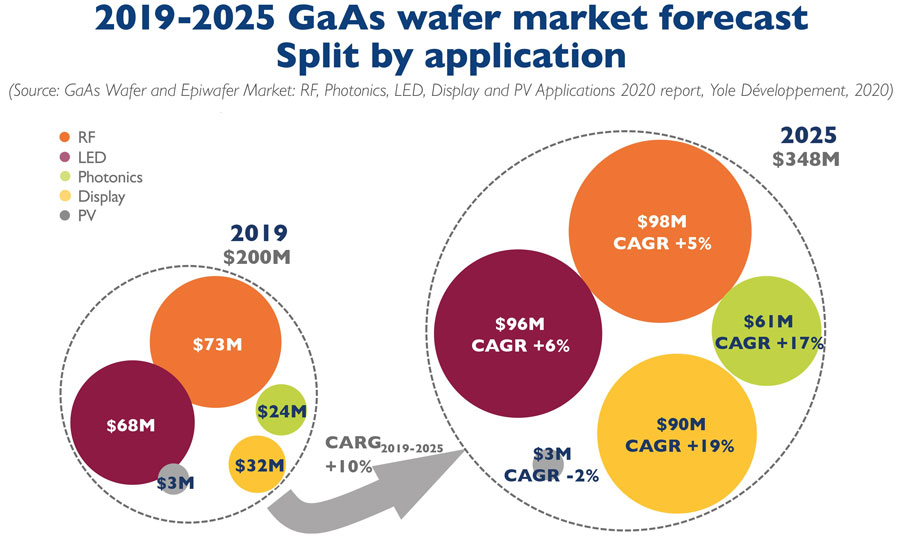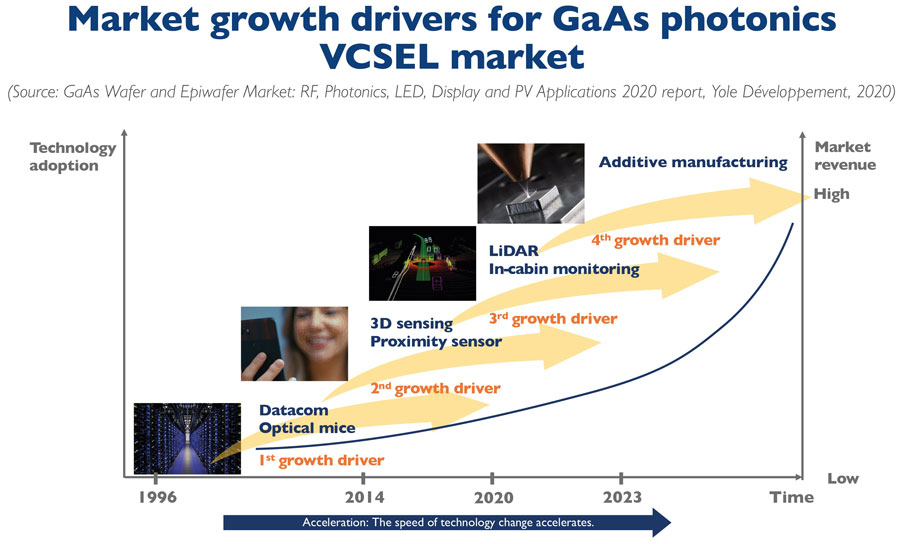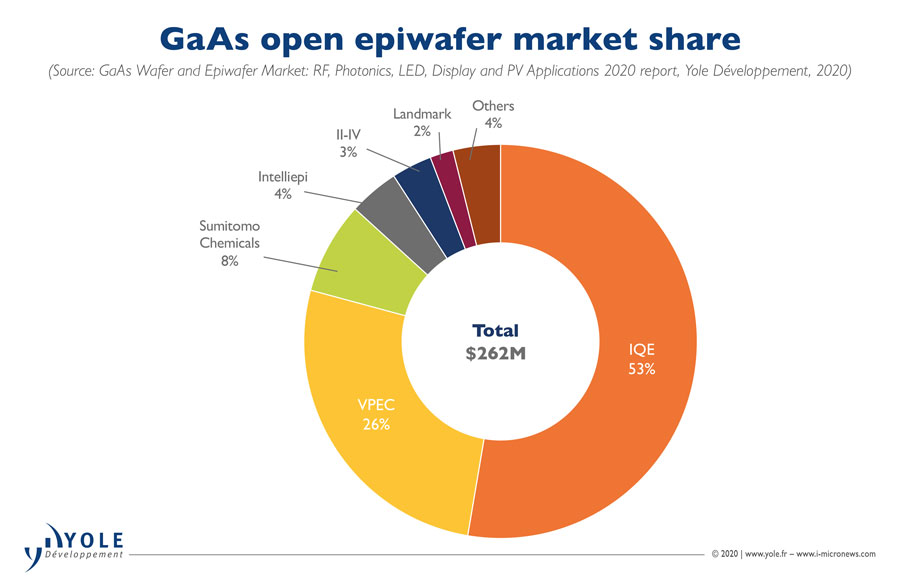News: Markets
2 June 2020
GaAs wafer market growing at 10% CAGR to over $348m by 2025
The total gallium arsenide (GaAs) wafer market is rising at a compound annual growth rate (CAGR) of 10% from US$200m in 2019 to more than US$348m by 2025, estimates Yole Développement’s new technology & market analysis report ‘GaAs Wafer and Epiwafer Market: RF, Photonics, LED, Display and PV Applications 2020’.

“RF is the historical market driver for GaAs wafers. In 2019 it represented 33% of market volume and 37% of market value. RF represents 67% of the GaAs epiwafer open market,” notes Ezgi Dogmus PhD, a member of the Power & Wireless division at Yole. “GaAs RF demand is mainly driven by handset evolution, with the transition to 5G resulting in greater penetration of GaAs power amplifiers (PAs) for the high-end sub-6GHz phones,” he adds.
“In the past few years, the GaAs wafer market has been dominated by RF application,” notes Ahmed Ben Slimane PhD., technology & market analyst specialized in Compound Semiconductors. “As of 2020, photonics and LEDs represent the main drivers for this markets,” he adds.
Photonics has a 5% share of GaAs wafer volume, corresponding to a $24m market. However, the photonics market will grow at a double-digit CAGR over 2019-2025, dominated by GaAs vertical-cavity surface-emitting laser (VCSEL) technology. In this context, photonics applications represent 32% of the GaAs epiwafer open market.
With the transition of LEDs from low-end applications to high-end applications (such as horticultural lighting or automotive), LEDs still represent the highest GaAs wafer market volume, with a 41% share. Automotive will be the main driver for visible LEDs and infrared (IR) LEDs, with a dynamic 6% CAGR estimated over 2019-2025.
Driven by hot new applications such as micro-LEDs, GaAs will find another source of growth in the display market, which is growing at a CAGR of 19% over 2019-2025, reckons Yole.

The 2020 edition of the ‘GaAs Wafer and Epiwafer Market’ report also takes into account the COVID-19 outbreak and its impact on multiple industries directly linked to GaAs-based technologies.
Without doubt consumer and automotive market segments will be strongly modified by the crisis. Consequently, the compound semiconductor team at Yole has included three different scenarios in the report, focused especially on market evolution and production recovery.
In the mobile market segment, Yole forecasts that the most likely scenario is a drop in production of 20% in 2020 compared with 2019. Also, some major original equipment manufacturers (OEMs) such as Samsung and Apple have re-positioned their products. In fact, due to a reduction in household income, OEMs expect a shift from high-end to mid-range and even entry-level smartphones. Regarding automotive applications, Yole forecasts a drop in production of about 30%.

From a supply-chain perspective, the GaAs epiwafer supply chain is constantly changing, notes Yole.
“In the photonics market, the epiwafer business model is application dependent,” notes Slimane. “In datacom, it is mostly integrated, dominated by Finisar, Avago and II-VI. However, for 3D sensing and other VCSELs for smartphones, manufacturers prefer to outsource the epitaxy, a less complicated strategy adopted by Apple, which is supplied by IQE,” he adds. “IQE remains the biggest epiwafer supplier, with 61% photonic epiwafer market share in 2019. But, with increased adoption of 3D sensing, numerous players such as VPEC, II-VI, Sumitomo Chemicals and Landmark are ramping up their production.”
The RF GaAs epitaxy market is about 90% outsourced. Previously it was largely dominated by IQE, but it has lost share to the Chinese-Taiwanese supply chain. As of 2019, IQE and VPEC represent more than 80% of the RF epi market. The LED epiwafer market remains almost entirely integrated within very well-established companies like Osram, San’an, Epistar and Changelight.
In terms of GaAs wafer supply, Freiberger, Sumitomo Electric, AXT and Vital Materials led the market in 2019. The top players have a bigger market share in high-end applications and, due to stringent laser-grade wafer specifications, they will maintain their advantage for the next 5-8 years, reckons Yole. Having only recently entered the market with low-end products for LEDs, the outlook for new Chinese GaAs suppliers is challenging, the firm adds. Also, their transition to high-end products and expansion out of China is risky due to potential IP infringement issues, Yole reckons.








